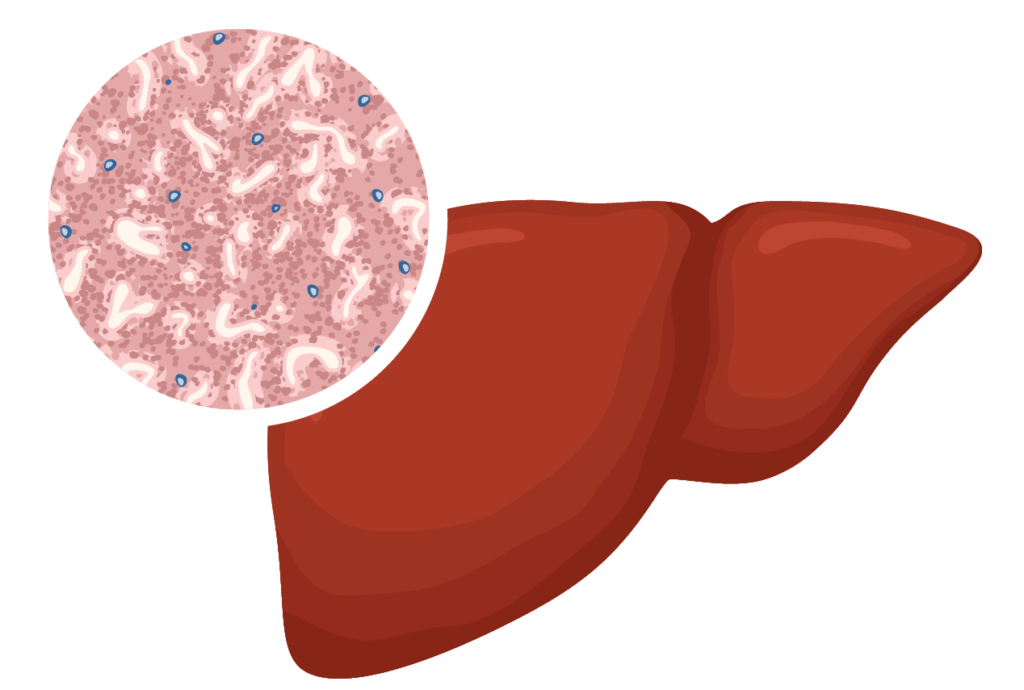What is fatty liver disease?

Nonalcoholic fatty liver disease (NAFLD) is the most common form of chronic liver disease in the United States, affecting about one-quarter of the population. If left untreated, it may progress into nonalcoholic steatohepatitis (NASH), an aggressive form of fatty liver disease, which is marked by liver inflammation and may progress to advanced scarring (cirrhosis) and liver failure.
NONALCOHOLIC FATTY LIVER DISEASE (NAFLD)
A condition in which excess fat is stored in your liver.
NONALCOHOLIC STEATOHEPATITIS (NASH)
A more severe form of NAFLD in which the buildup of fat in the liver causes inflammation and cell damage.
Often NAFLD and NASH cause few or no symptoms. Certain health conditions—including obesity, metabolic syndrome, and type 2 diabetes— make you more likely to develop NAFLD and NASH.
What is fatty liver disease?
Nonalcoholic fatty liver disease (NAFLD) is the most common form of chronic liver disease in the United States, affecting about one-quarter of the population. If left untreated, it may progress into nonalcoholic steatohepatitis (NASH), an aggressive form of fatty liver disease, which is marked by liver inflammation and may progress to advanced scarring (cirrhosis) and liver failure.
NONALCOHOLIC FATTY LIVER DISEASE (NAFLD)
A condition in which excess fat is stored in your liver.
NONALCOHOLIC STEATOHEPATITIS (NASH)
A more severe form of NAFLD in which the buildup of fat in the liver causes inflammation and cell damage.
Often NAFLD and NASH cause few or no symptoms. Certain health conditions—including obesity, metabolic syndrome, and type 2 diabetes— make you more likely to develop NAFLD and NASH.

Fatty Liver Disease Timeline

Healthy Liver
The liver is very resilient and capable of regenerating itself. If not taken care of, after many years it will reduce its ability to regenerate.

NAFLAD
NAFLD is more common in people who have certain conditions, including obesity, type 2 diabetes, and metabolic syndrome.

NAFLAD
Often NAFLD and NASH cause few or no symptoms. Certain health conditions—including obesity, metabolic syndrome, and type 2 diabetes— make you more likely to develop NAFLD and NASH.

Cirrhosis
Cirrhosis is a late stage of scarring (fibrosis) of the liver. Severe scarring has built up, making it difficult for the liver to function properly.
Health conditions that can increase your risk
NAFLD is more common in people who have certain conditions, including obesity, type 2 diabetes, and metabolic syndrome. Among individuals with type 2 diabetes, the prevalence of NAFLD is over 60% in the U.S.
Risk Factors
Some diseases and conditions can increase your risk of NAFLD and NASH, including:
Obesity
Type 2 Diabetes
Cardiovascular Disease
Hypertriglyceridemia
Hyperlipidemia
Hypertension
Genetic Factors
People of Hispanic or Asian descent are more likely to possess a variant of the
PNPLA3 gene, which can increase your risk for NAFLD and NASH
Should I consider Screening for Inclusion in a clinical Trial?
People take part in clinical trials for many reasons. When you volunteer to participate in a clinical trial you help researchers learn more about treating and preventing fatty liver disease, as well as improve healthcare for people in the future. In addition to helping others, you may receive the newest treatments for NAFLD and NASH.
Clinical trials are closely regulated by the FDA and are required to follow the same ethical and legal guidelines as standard medical practice to protect the safety of participants. However, before participating in a clinical study, it’s important that you talk to your healthcare provider and learn about the study’s potential risks and benefits.
NASH Pass Clinical Trial Screening Steps
Discuss your eligibility with your healthcare provider
Schedule a screening visiting, which will involve a single blood draw and possibly a simple, non-invasive ultrasound imaging procedure of your liver (FibroScan)
Follow-up call or appointment with your healthcare provider to discuss next steps, which may include another imaging procedure, such as an MRI, or a liver biopsy to confirm your diagnosis if your original assessments indicate NASH
Discuss and consider opportunities to participate in a clinical trial
